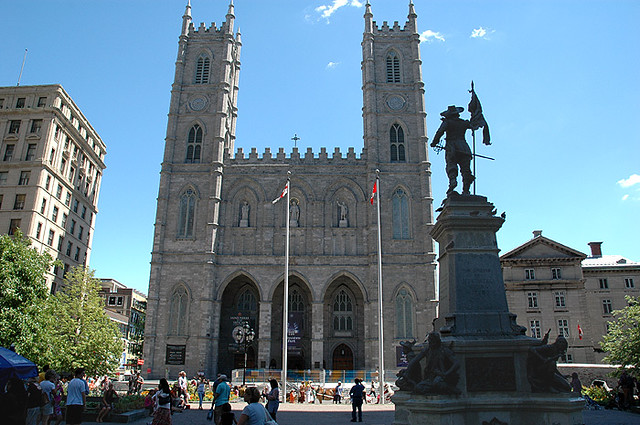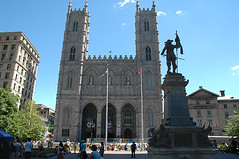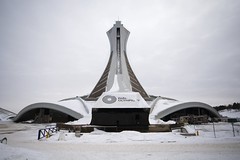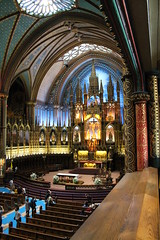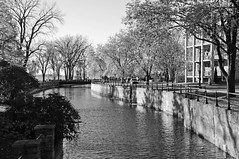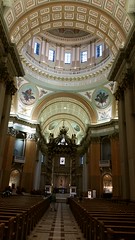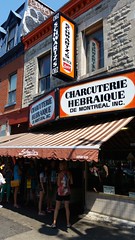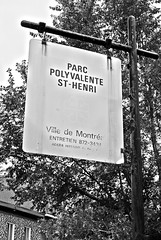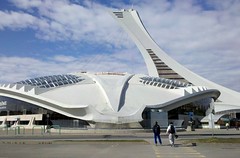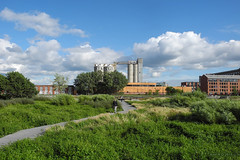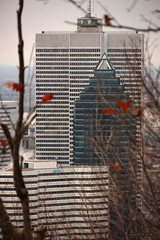Longueuil
Longueuil (French: [lɔ̃ɡœj]) is a city in the province of Quebec, Canada. It is the seat of the Montérégie administrative region and the central city of the urban agglomeration of Longueuil. It sits on the south shore of the Saint Lawrence River directly across from Montreal. The population as of the Canada 2016 Census totalled 239,700, making it Montreal's second largest suburb, the fifth most populous city in Quebec and twentieth largest in Canada.
Charles Le Moyne founded Longueuil as a seigneurie in 1657. It would become a parish in 1845, a village in 1848, a town in 1874 and a city in 1920. Between 1961 and 2002, Longueuil's borders grew three times, as it was amalgamated with surrounding municipalities; there was a strong de-amalgamation in 2006 (see 2000–2006 municipal reorganization in Quebec).
Longueuil is a residential, commercial and industrial city. It incorporates some urban features, but is essentially a suburb. Longueuil can be classified as a commuter town as a large portion of its residents commute to work in Montreal. Most buildings are single-family homes constructed in the post-war period. The city consists of three boroughs: Le Vieux-Longueuil, Saint-Hubert and Greenfield Park.
Longueuil is the seat of the judicial district of Longueuil. Residents of the city are called Longueuillois.
History
The territory of New France was divided into seigneuries in order to ensure the colony's defence. Longueuil was founded in 1657 by Charles Le Moyne, a merchant from Ville-Marie (present day Montreal), as a seigneurie. According to Abbé Faillon, Charles Le Moyne, lord of the area starting in 1657, named Longueuil after the village of Longueil (note slightly different spelling) which is today the seat of a canton in the district of Dieppe in his homeland of Normandy.
His son, Charles Le Moyne de Longueuil, built Fort Longueuil as his fortified residence. It was constructed of stone between 1685 and 1690 and had four towers.
Fort Longueuil was believed to be occupied by American troops during the American Revolutionary War. It was subsequently occupied by the British. It was demolished in 1810 due to its poor condition. The archaeological remains of Fort Longueuil were recognized as a National Historic Site of Canada on May 25, 1923. The site extends beneath the present-day Saint-Antoine-de-Padoue Cathedral.
The seigneurial system ended in 1845 and Longueuil was turned into a parish municipality named Saint-Antoine-de-Longueuil. In 1848, a portion detached from the parish and officially established as the village of Longueuil. This same village became a town in 1874, and then a city in 1920. Musician Paul Pratt notably served as the city's mayor from 1935 to 1966.
Longueuil's city limits expanded for the first time in 1961 when it merged with Montréal-Sud, and again in 1969 when it merged with Ville Jacques-Cartier. In both cases, Longueuil was chosen as the name of the new city.
On January 1, 2002, as part of the 2000–2006 municipal reorganization in Quebec, the provincial government amalgamated the former Longueuil with Boucherville, Brossard, Greenfield Park, LeMoyne, Saint-Bruno-de-Montarville, Saint-Hubert and Saint-Lambert. As with the 1960s, the name Longueuil was chosen for the new city. However, after a change of government and a 2004 referendum, Boucherville, Brossard, Saint-Lambert and Saint-Bruno-de-Montarville were re-constituted as independent cities on January 1, 2006. As such, the current city of Longueuil now includes only the former cities of Longueuil (1969-2002), Saint-Hubert, Greenfield Park and LeMoyne.
Geography
Longueuil occupies 115.59 square kilometres (44.6 sq mi) of land. The city is bordered by the cities of Saint-Lambert to the west, Brossard to the southwest, Boucherville to the northeast, Saint-Bruno-de-Montarville to the east, and the Saint Lawrence River and Montreal to the northwest. The city of Longueuil is located approximately 7 kilometres (5 mi) east of Montreal on the south shore of the Saint Lawrence River.
Longueuil is located in the Saint Lawrence River valley, and is a vast plain. Areas near the river were originally swamp land with mixed forest, and later prime agricultural land. Agricultural land still exists in the portions of the city furthest from the river.
The city of Longueuil also includes Île Charron, a small island in the Saint Lawrence River, and part of the Boucherville Islands.
Street addresses in Longueuil increase west and east from the Chemin de Chambly, with suffixes of "Ouest" and "Est" used on east-west streets that cross it, and south from the Saint Lawrence River. (As in Montreal, the local cardinal directions are skewed to align with the shore of the river, and local grid "north" is closer to geographic northwest)
Demographics
In the 2021 Census of Population conducted by Statistics Canada, Longueuil had a population of living in of its total private dwellings, a change of from its 2016 population of . With a land area of , it had a population density of in 2021.
Of the 132,570 workers in Longueuil, the median income was $26,537, which is above Quebec's provincial average of $25,464. Among the 69,990 full-time workers, the median income was $37,521 or slightly below the provincial average. Several of Montreal's most impoverished neighborhoods are located in Longueuil.
Language
As of the 2011 Canadian Census, French was the mother tongue language of 81.4% of Longueuil's residents while English was the first language of 7.5%. Other languages were spoken by 13.6% of the population, with the most spoken being Spanish (3.0%), Arabic (2.1%), Haitian Creole (1.2%), Romanian (0.7%), Persian (0.7%), Chinese (0.6%), Italian (0.6%) and Portuguese (0.6%). These figures include multiple responses.
| Canada Census Mother Tongue - Longueuil, Quebec | ||||||||||||||||||
|---|---|---|---|---|---|---|---|---|---|---|---|---|---|---|---|---|---|---|
| Census | Total | |||||||||||||||||
| Year | Responses | Count | Trend | Pop % | Count | Trend | Pop % | Count | Trend | Pop % | Count | Trend | Pop % | |||||
| 181,075 | 0.89% | 71.9% | 14,565 | 4.78% | 5.7% | 4,460 | 79.47% | 1.77% | 44,810 | 30.6% | 17.79% | |||||||
| 182,705 | 0.49% | 76.87% | 13,900 | 1.8% | 5.84% | 2,485 | 0.1% | 1.04% | 34,310 | 22.1% | 14.44% | |||||||
| 181,800 | 0.0005% | 79.21% | 14,155 | 8.05% | 6.17% | 2,460 | 37.05% | 1.07% | 28,115 | 0.97% | 12.25% | |||||||
| 181,790 | 1.40% | 80.15% | 15,395 | 10.87% | 6.79% | 1,795 | 4.5% | 0.81% | 27,845 | 56.86% | 12.28% | |||||||
| 184,380 | 0.39% | 84.26% | 13,885 | 17.22% | 6.35% | 1,880 | 17.74% | 0.86% | 17,795 | 5.95% | 8.13% | |||||||
| 183,065 | n/a | 82.99% | 16,775 | n/a | 7.60% | 2,285 | n/a | 1.04% | 16,795 | n/a | 7.61% | |||||||
| Top 20 languages Longueuil, 2016 | Population | % |
|---|---|---|
| French | 182,705 | 79.1 |
| English | 13,900 | 6.0 |
| Spanish | 7,830 | 3.4 |
| Arabic | 5,235 | 2.3 |
| Creole | 2,805 | 1.2 |
| Romanian | 1,985 | 1.0 |
| Farsi | 1,885 | 0.8 |
| Portuguese | 1,475 | 0.6 |
| Mandarin | 1,390 | 0.6 |
| Russian | 1,180 | 0.5 |
| Italian | 1,160 | 0.5 |
| Vietnamese | 970 | 0.4 |
| Cantonese | 845 | 0.4 |
| Kabyle | 575 | 0.2 |
| Greek | 565 | 0.2 |
| Polish | 345 | 0.1 |
| Lao | 340 | 0.1 |
| Bulgarian | 330 | 0.1 |
| Wolof | 305 | 0.1 |
| German | 280 | 0.1 |
Ethnicity
| Ethnic Origin | Population | Percent |
|---|---|---|
| Canadian | 132,210 | 58.3% |
| French | 68,325 | 30.1% |
| Irish | 14,115 | 6.2% |
| English | 8,075 | 3.6% |
| Italian | 7,870 | 3.5% |
| First Nations | 6,780 | 3% |
| Scottish | 6,635 | 2.9% |
| Québécois | 5,630 | 2.5% |
| Haitian | 5,140 | 2.3% |
| German | 4,870 | 2.1% |
| Spanish | 3,315 | 1.5% |
| Chinese | 3,080 | 1.4% |
| Portuguese | 2,590 | 1.1% |
People of European origins made up 87.6% of the population in 2006. The largest visible minority groups are Black (4.1%), Latin American (2%), Arab (1.6%), Chinese (1.2%), Southeast Asian (1%), and South Asian (0.7%).
| Panethnic group | 2021 | 2016 | 2011 | 2006 | 2001 | |||||||||
|---|---|---|---|---|---|---|---|---|---|---|---|---|---|---|
| Population | ||||||||||||||
| European | 183,935 | 188,900 | 193,360 | 198,620 | 116,660 | |||||||||
| African | 24,910 | 16,510 | 10,500 | 9,230 | 3,520 | |||||||||
| Middle Eastern | 13,880 | 9,360 | 6,565 | 4,750 | 1,865 | |||||||||
| Latin American | 11,400 | 7,355 | 5,810 | 4,580 | 1,205 | |||||||||
| East Asian | 4,870 | 3,700 | 3,235 | 3,030 | 1,070 | |||||||||
| Southeast Asian | 3,550 | 3,100 | 3,085 | 2,865 | 1,280 | |||||||||
| Indigenous | 3,255 | 2,440 | 2,230 | 1,360 | 420 | |||||||||
| South Asian | 2,605 | 1,895 | 2,085 | 1,610 | 480 | |||||||||
| Other/Multiracial | 2,035 | 1,690 | 1,105 | 770 | 265 | |||||||||
| Total responses | 250,430 | 234,955 | 227,970 | 226,820 | 126,760 | |||||||||
| Total population | 254,483 | 239,700 | 231,409 | 229,330 | 128,016 | |||||||||
Arts and culture
The Longueuil International Percussion Festival, which features 500 musicians, takes place over six days in July in the neighbourhood of Old Longueuil, and draws 200,000 visitors per year.
Attractions
There are three nature parks in Longueuil, Parc Marie-Victorin and Parc Michel-Chartrand in Le Vieux-Longueuil and Parc de la Cité in Saint-Hubert. It is also home to a wildlife reserve, the Boisé du Tremblay, which is partially in Le Vieux-Longueuil and partially in Boucherville.
There are seven arenas: Cynthia Coull Arena in Greenfield Park; Aréna Émile-Butch-Bouchard, Aréna Jacques-Cartier, Aréna Olympia and Colisée Jean Béliveau in Le Vieux-Longueuil; and Centre sportif Gaétan-Boucher and Centre sportif Rosanne-Laflamme in Saint-Hubert.
Notable places of worship include the Roman Catholic Co-Cathedral of Saint-Antoine-de-Padoue, the Église Nouvelle vie evangelical church, , and the Montréal Québec Temple of the Church of Jesus Christ of Latter-day Saints.
Infrastructure
Commuting patterns
According to the 2006 Census, about 39,485 city residents (17.2% of the total population) commute to work in Montreal on a daily basis, while only 38,090 residents (16.6%) work in the city itself. A further 6,915 residents (3.0%) work in Boucherville every day, 4,775 (2.1%) work in Brossard, 2,795 (1.2%) in Saint-Bruno-de-Montarville, and 1,815 (0.8%) work in Saint-Lambert, the four other constituent cities of the Longueuil agglomeration.
By contrast only 8,845 people commute from Montreal to work in Longueuil every day, while 4,080 people commute from Brossard to work in Longueuil, 2,940 people commute from Boucherville, 2,090 from Sainte-Julie, 1,825 from Saint-Bruno-de-Montarville, 1,815 from Chambly, and 1,810 from Saint-Jean-sur-Richelieu.
Roads
The Saint Lawrence River between the Island of Montreal and the south shore is traversed by only five automobile crossings. Two of these are in Longueuil, the Louis Hippolyte Lafontaine Tunnel (part of Autoroute 25) and the Jacques Cartier Bridge (part of Route 134).
Autoroute 20 is an important highway in Longueuil, bordering the Saint Lawrence River in the Le Vieux-Longueuil borough, where it co-exists with Autoroute René-Lévesque (Route 132), and finally heading eastward toward Boucherville. Autoroute 30 crosses the Saint-Hubert borough in the southern part of…
Looking for places related to Longueuil?
Those are other destinations to find places related to Longueuil:
